The Rain Sensors Market is estimated to be valued at USD 1.3 billion in 2025 and is projected to reach USD 2.6 billion by 2035, registering a compound annual growth rate (CAGR) of 6.8% over the forecast period.
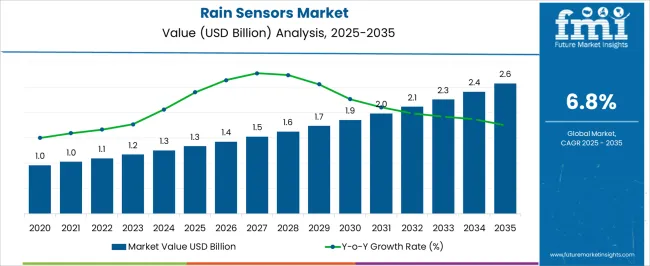
| Metric | Value |
|---|---|
| Rain Sensors Market Estimated Value in (2025 E) | USD 1.3 billion |
| Rain Sensors Market Forecast Value in (2035 F) | USD 2.6 billion |
| Forecast CAGR (2025 to 2035) | 6.8% |
The Rain Sensors market is experiencing steady growth as automotive and transportation industries increasingly prioritize safety, convenience, and automated vehicle functionality. The current market landscape is shaped by the rising demand for smart vehicle technologies, particularly in regions with high vehicle density and variable climatic conditions. Integration of rain sensors enables automated wiper control, improved driver visibility, and enhanced safety, which has contributed significantly to adoption rates.
Technological advancements in sensor accuracy, response speed, and reliability have further accelerated market acceptance. Increasing investments by vehicle manufacturers in advanced driver assistance systems and connected car features are creating substantial opportunities for growth.
The shift towards electric and autonomous vehicles has further underscored the importance of automated environmental sensing systems As regulatory frameworks for vehicle safety become more stringent, the deployment of rain sensors is expected to expand, providing an opportunity for manufacturers to innovate with standalone and integrated solutions that enhance operational efficiency and passenger safety.
The rain sensors market is segmented by installation type, technology, application, and geographic regions. By installation type, rain sensors market is divided into Standalone Rain Sensors and In-A-Network Rain Sensors. In terms of technology, rain sensors market is classified into Optical, Mechanical, Chemical, and Conductive. Based on application, rain sensors market is segmented into Wiper Control, Condensation Sensing, Drop Detection, Irrigation Control, and Others. Regionally, the rain sensors industry is classified into North America, Latin America, Western Europe, Eastern Europe, Balkan & Baltic Countries, Russia & Belarus, Central Asia, East Asia, South Asia & Pacific, and the Middle East & Africa.
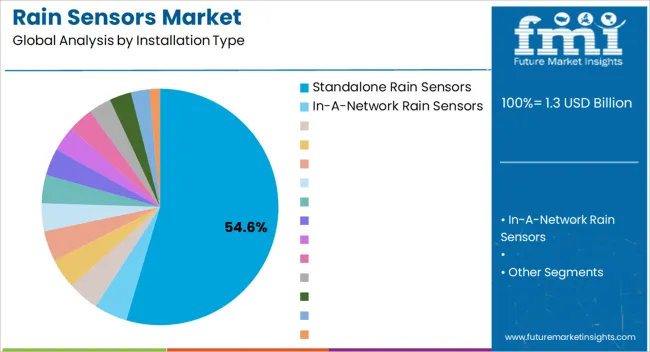
The Standalone rain sensors segment is projected to hold 54.60% of the Rain Sensors market revenue share in 2025, establishing it as the leading installation type. This dominance has been driven by its ease of integration into existing vehicle platforms and compatibility with multiple wiper and vehicle control systems. Adoption has been facilitated by growing demand for retrofit options in commercial and personal vehicles, allowing automated wiper control without extensive modifications to the vehicle’s electronics.
The simplicity of installation and the reduced need for complex calibration have enhanced its popularity among manufacturers and fleet operators. Additionally, standalone sensors offer high accuracy and rapid response to precipitation, which improves safety and driver convenience.
Increasing consumer awareness of automated vehicle features and vehicle manufacturers’ focus on differentiating safety technologies are expected to sustain growth in this segment The scalability and flexibility offered by standalone rain sensors ensure that they will continue to be favored in both mature and emerging automotive markets.
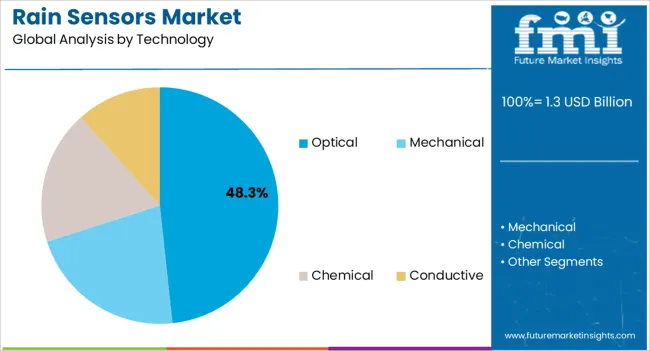
The Optical technology segment is expected to account for 48.30% of the Rain Sensors market revenue share in 2025, making it the leading technology type. Growth in this segment has been driven by its high sensitivity, rapid response to changing weather conditions, and low maintenance requirements. Optical sensors are capable of detecting small changes in raindrop intensity, enabling precise wiper activation and improved vehicle safety.
The adoption of optical sensors has been supported by advances in sensor miniaturization and durability, which allow integration into modern vehicle windshields without obstructing driver visibility. Optical systems are preferred in both high-end and mid-range vehicles due to their accuracy and reliability under diverse environmental conditions.
As automotive manufacturers increasingly focus on delivering automated and semi-autonomous driving experiences, optical rain sensors are being deployed widely for consistent performance and enhanced driver assistance features The segment’s growth is expected to continue as the emphasis on safety automation and smart vehicle functionality intensifies globally.
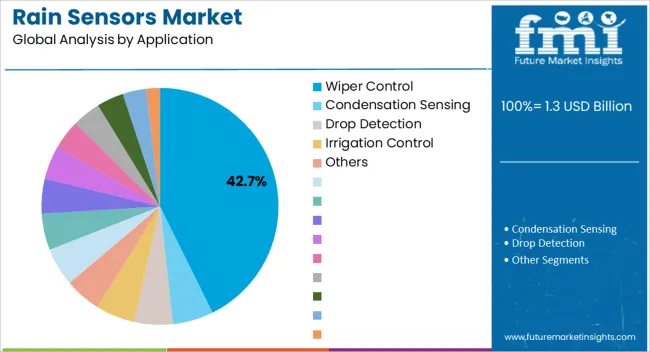
The Wiper Control application segment is anticipated to hold 42.70% of the Rain Sensors market revenue share in 2025, making it the dominant application. This prevalence has been driven by the increasing integration of rain sensors with automated windshield wipers in passenger and commercial vehicles, improving driver convenience and safety.
The segment has benefited from widespread adoption in regions with high rainfall and variable weather conditions, where automated wiper activation reduces distraction and enhances visibility. Technological developments in sensor response speed and accuracy have further facilitated market growth by enabling precise detection of precipitation intensity and immediate adjustment of wiper speed.
Additionally, automotive manufacturers’ focus on driver assistance features, vehicle automation, and comfort has accelerated the deployment of rain sensors for wiper control The segment is expected to continue expanding as regulatory standards for vehicle safety and visibility become more stringent, and as manufacturers increasingly integrate automated environmental sensing systems into vehicles to meet consumer demand for advanced safety technologies.
Rain sensors have been into existence since the latter half of the twentieth century in the market. However, observable traction of the product has been witnessed since the past few years. One of the major reason responsible for the sudden adoption of rain sensors was a demand for an automated wiper control in an automobile.
Rain sensors are sensors, functioning over varying technologies, which senses the presence of precipitation and offer the expected response against the same. The two major applications of rain sensors are the operation of wipers of an automobile automatically, and conservation of water during irrigational purposes.
Rain Sensors have witnessed significant traction over the past four years, owing to the increasing adoption of the same in automobiles and increasing awareness about conservation of water globally, amongst end-users. Because of the considerable growth opportunity associated with the market, complimented by the presence of an unaddressed market, rain sensors market is expected to exhibit a relatively slower double digit growth rate during the forecast period, in terms of value.
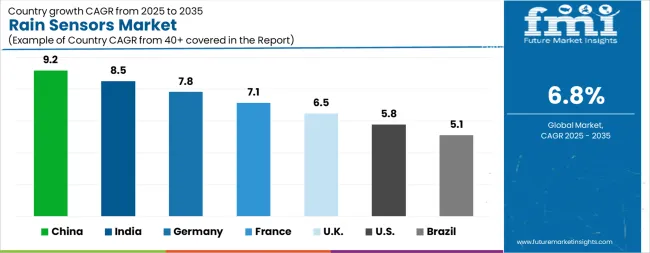
| Country | CAGR |
|---|---|
| China | 9.2% |
| India | 8.5% |
| Germany | 7.8% |
| France | 7.1% |
| UK | 6.5% |
| USA | 5.8% |
| Brazil | 5.1% |
The Rain Sensors Market is expected to register a CAGR of 6.8% during the forecast period, exhibiting varied country level momentum. China leads with the highest CAGR of 9.2%, followed by India at 8.5%. Developed markets such as Germany, France, and the UK continue to expand steadily, while the USA is likely to grow at consistent rates. Brazil posts the lowest CAGR at 5.1%, yet still underscores a broadly positive trajectory for the global Rain Sensors Market. In 2024, Germany held a dominant revenue in the Western Europe market and is expected to grow with a CAGR of 7.8%. The USA Rain Sensors Market is estimated to be valued at USD 459.9 million in 2025 and is anticipated to reach a valuation of USD 806.7 million by 2035. Sales are projected to rise at a CAGR of 5.8% over the forecast period between 2025 and 2035. While Japan and South Korea markets are estimated to be valued at USD 62.5 million and USD 35.6 million respectively in 2025.
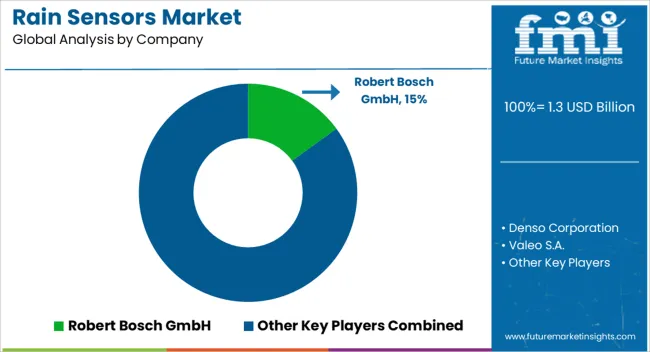
| Item | Value |
|---|---|
| Quantitative Units | USD 1.3 Billion |
| Installation Type | Standalone Rain Sensors and In-A-Network Rain Sensors |
| Technology | Optical, Mechanical, Chemical, and Conductive |
| Application | Wiper Control, Condensation Sensing, Drop Detection, Irrigation Control, and Others |
| Regions Covered | North America, Europe, Asia-Pacific, Latin America, Middle East & Africa |
| Country Covered | United States, Canada, Germany, France, United Kingdom, China, Japan, India, Brazil, South Africa |
| Key Companies Profiled | Robert Bosch GmbH, Denso Corporation, Valeo S.A., HELLA GmbH & Co. KGaA, Mitsubishi Motors Corporation, TRW Automotive Holdings Corp., Melexis Microelectronic Integrated Systems, Hamamatsu Photonics K.K., Sensata Technologies, Murata Manufacturing Co., Ltd., ZF Friedrichshafen AG, HYUNDAI MOBIS, Continental AG, and Alps Alpine Co., Ltd. |
The global rain sensors market is estimated to be valued at USD 1.3 billion in 2025.
The market size for the rain sensors market is projected to reach USD 2.6 billion by 2035.
The rain sensors market is expected to grow at a 6.8% CAGR between 2025 and 2035.
The key product types in rain sensors market are standalone rain sensors and in-a-network rain sensors.
In terms of technology, optical segment to command 48.3% share in the rain sensors market in 2025.






Our Research Products

The "Full Research Suite" delivers actionable market intel, deep dives on markets or technologies, so clients act faster, cut risk, and unlock growth.

The Leaderboard benchmarks and ranks top vendors, classifying them as Established Leaders, Leading Challengers, or Disruptors & Challengers.

Locates where complements amplify value and substitutes erode it, forecasting net impact by horizon

We deliver granular, decision-grade intel: market sizing, 5-year forecasts, pricing, adoption, usage, revenue, and operational KPIs—plus competitor tracking, regulation, and value chains—across 60 countries broadly.

Spot the shifts before they hit your P&L. We track inflection points, adoption curves, pricing moves, and ecosystem plays to show where demand is heading, why it is changing, and what to do next across high-growth markets and disruptive tech

Real-time reads of user behavior. We track shifting priorities, perceptions of today’s and next-gen services, and provider experience, then pace how fast tech moves from trial to adoption, blending buyer, consumer, and channel inputs with social signals (#WhySwitch, #UX).

Partner with our analyst team to build a custom report designed around your business priorities. From analysing market trends to assessing competitors or crafting bespoke datasets, we tailor insights to your needs.
Supplier Intelligence
Discovery & Profiling
Capacity & Footprint
Performance & Risk
Compliance & Governance
Commercial Readiness
Who Supplies Whom
Scorecards & Shortlists
Playbooks & Docs
Category Intelligence
Definition & Scope
Demand & Use Cases
Cost Drivers
Market Structure
Supply Chain Map
Trade & Policy
Operating Norms
Deliverables
Buyer Intelligence
Account Basics
Spend & Scope
Procurement Model
Vendor Requirements
Terms & Policies
Entry Strategy
Pain Points & Triggers
Outputs
Pricing Analysis
Benchmarks
Trends
Should-Cost
Indexation
Landed Cost
Commercial Terms
Deliverables
Brand Analysis
Positioning & Value Prop
Share & Presence
Customer Evidence
Go-to-Market
Digital & Reputation
Compliance & Trust
KPIs & Gaps
Outputs
Full Research Suite comprises of:
Market outlook & trends analysis
Interviews & case studies
Strategic recommendations
Vendor profiles & capabilities analysis
5-year forecasts
8 regions and 60+ country-level data splits
Market segment data splits
12 months of continuous data updates
DELIVERED AS:
PDF EXCEL ONLINE
Strain Type Pressure Sensors Market Size and Share Forecast Outlook 2025 to 2035
Wireless Brain Sensors Market
Automotive Powertrain Sensors Market
RAIN Tag Antennas Market Size and Share Forecast Outlook 2025 to 2035
Rain Barrels Market Size and Share Forecast Outlook 2025 to 2035
Rainbow Flatware Market Trends - Growth & Forecast 2025 to 2035
Rain Boots Market Trends - Growth & Industry Forecast 2025 to 2035
Rainscreen Cladding Market Growth - Trends & Forecast 2025 to 2035
Market Share Breakdown of Rain Barrel Manufacturers
Grain Hardness Meter Market Size and Share Forecast Outlook 2025 to 2035
Grain Cooling Spear Market Size and Share Forecast Outlook 2025 to 2035
Train Antenna Market Size and Share Forecast Outlook 2025 to 2035
Brain Monitoring Market Size and Share Forecast Outlook 2025 to 2035
Brain Fitness Market Size and Share Forecast Outlook 2025 to 2035
Train Control and Management Systems Market Size and Share Forecast Outlook 2025 to 2035
Draining Cellulite Treatments Market Size and Share Forecast Outlook 2025 to 2035
Brain Computing Interfaces Market Size and Share Forecast Outlook 2025 to 2035
Brain Cancer Diagnostics Market Size and Share Forecast Outlook 2025 to 2035
Draining Agents Market Size and Share Forecast Outlook 2025 to 2035
Train Dispatching Market Size and Share Forecast Outlook 2025 to 2035

Thank you!
You will receive an email from our Business Development Manager. Please be sure to check your SPAM/JUNK folder too.
Chat With
MaRIA